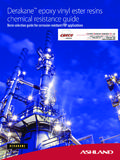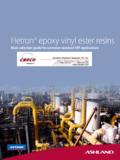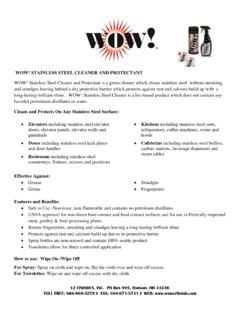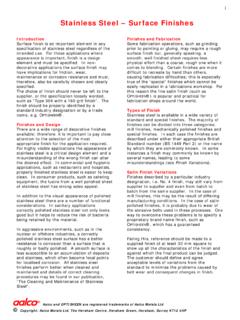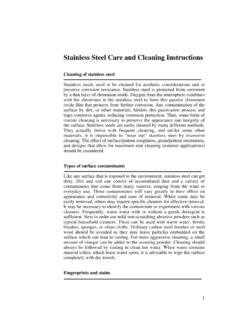Transcription of MATERIAL & WELDING FINISHES FOR SANITARY …
1 MATERIAL & WELDING FINISHES FOR SANITARY stainless steel EQUIPMENT. This general information defines terminology and fabrication methods for stainless steel MATERIAL FINISHES and weld FINISHES . It is important to define the requirements of the customer in order to select the appropriate finish (See Table 1). Table 1 defines surface finish numbers in terms of abrasive grit sizes and surface roughness. A. TERMINOLOGY. 1. Average Arithmetic Roughness - Ra, a measurement of surface roughness, is the average deviation from a mean surface and is measured in micro inches or microns.
2 Ra ( ) = RMS. 2. Root Mean Square (RMS) is a measurement of surface roughness and is proportional to Ra. 3. Surface Roughness is an indication of the marks left on the metal surface by mechanical working, grinding or polishing. 4. Grit refers to the standard mesh size of the abrasives. 5. Mechanical Grinding is a rough finishing method in which metal from weld beads and flash from forgings, castings etc., shall be removed. 6. Mechanical Polishing is a finishing method, which removes scratches, marks or rough surfaces. The degree of polish achieved is dependent on the grain size or grit of the abrasive used.
3 7. Buffing is a special mechanical polishing operation using high-speed cloth wheels and extremely fine abrasives. 8. Electropolishing refers to a process where surface metal is removed and leveled by anodic dissolution in an electrolytic solution with an imposed current. Electropolishing passivates the surface creating a mirror finish without the use of mechanical polishing. 1. B. SURFACE FINISHING. 1. Polished surfaces shall undergo a series of polishing steps with increasingly finer grit abrasives until the required surface roughness is achieved.
4 The final polish shall be performed with abrasives at least as fine as indicated on Table 1. 2. The polishing abrasives used shall be either aluminum oxide or silicon carbide sandpaper. C. ELECTROPOLISH. 1. This electrochemical process for providing product surface integrity beyond available conventional mechanical FINISHES is provided in a range from 150. grit finish to 320 grit finish. Electropolishing stainless steel vessels obtains improved corrosion resistance by: reducing the exposed product surface area; removal of metallic and nonmetallic surface inclusions; obtaining a smooth releasable surface for improved cleanability; and removing some or all of the cold worked/structurally modified abrasive finished surface to expose unmodified base metal.
5 The resulting surface is effectively passivated with the resulting chrome oxide film reformed to a maximum obtainable thickness. 2. Electropolishing process shall reduce the surface roughness of mechanically polished surfaces by the following amounts: 40 percent at Ra, greater than 20 micro inches 30 percent at Ra, less than or equal to 20 micro inches D. FABRICATION. 1. Manual WELDING : GTAW - Gas Tungsten Arc Weld (TIG). GMAW - Gas Metal Arc Weld (MIG). E. INSPECTION AND TESTS. a. If required, sample coupon of the required finish shall be furnished.
6 Sample shall include a typical finish weld, and be used for comparison with the finished product. b. If inspection by customer is required and specified, then the quality of the surface finish for each piece of equipment can be inspected by any or all of the following methods: 1. Compared with the quality of the Seller submitted sample. 2. 2. Surface tested with profilometer. 3. Visual inspection. WELD SEAM FINISH (BRIEF DESCRIPTION) ALSO APPLIES TO SHEET & PLATE FINISH. As Welded All spatter, smoke and weld discoloration will remain since no grinding or clean up is performed on the weld or surrounding area.
7 B. Cleaned and Smooth This finish is not flush and will contain irregularities on the remaining weld. When compared to all the abrasive finishing methods, this process results in the least amount of weld MATERIAL removed. C. Smooth (high grade) Although not flush, welds are blended and smooth with no irregularities. D. 80 grit to 100 grit The weld will be ground flush and discoloration will be removed. Deep1 coarse grit lines will remain in the weld and weld area. Some pits and defects may also remain. E. 120 grit The weld will be ground flush and discoloration will be removed.
8 This surface is a near SANITARY finish. Pits and defects are minimized. F. 150 grit The weld is ground flush with all pits and defects removed. This finish is normally used with a #4. finish for SANITARY applications. G 180 grit The weld has finer grit lines than the 150 grit finish. It has improved appearance and will provide good product release and cleanability H 240 grit The weld finish shows higher reflectivity than the 180 grit finish. It has better product release and cleanability than a 180 grit I. 320 grit The weld surface shows minimal grit lines and provides for excellent product release and cleanability.
9 3. TABLE 1. stainless steel FINISHES . Surface Metal Working Final Polish Ra RMS. Finish # Methods Grit Size Microinch Microinch Hot roll, anneal N/a 1 Unpolished 500. and descale Cold roll, anneal 2D Unpolished 125 N/a and descale Cold roll, anneal descale and final light 2B Unpolished 80 N/a cold roll with polished rolls Mechanical polishing 3 100 60 67. on #1, 2D or 2B. Mechanical polishing 3 120 52 58. on #1, 2D or 2B. 4. Mechanical polishing standard 150 42 47. on 2B or 2D. SANITARY 4. Mechanical polishing high grade 180 30 34. on 2B or 2D. SANITARY 4.
10 Mechanical polishing ultra high 240 15 17. on 2B or 2D. SANITARY Mechanical buffing 7 320 12 14. on # 4. Mechanical buffing 8 400 5 7. on # 4. These values have been compiled from published literature for the purpose of design and manufacturing of SANITARY equipment. These values are the average data of many tests. Therefore, slight deviations do exist. Reasonable accuracy is assumed. Since many variables create this data, deviations of +/- 5% should be considered within good measurement parameters. 4.
